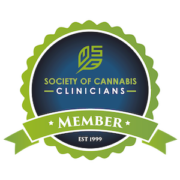Cannabis and Sleep Part 2
Advice from Dr. Dustin Sulak, Co-Founder and Medical Director of Healer.com:
- I almost always recommend THC-dominant cannabis before bed in patients with poor sleep.
- I’ve seen mixed results with CBD-dominant products on sleep. While CBD and CBDA do help some people sleep, often by mitigating anxiety or pain, I also estimate that low and moderate doses of CBD disturb sleep in 10% of my patients who try it.
- Inhaled cannabis 15–30 min before bedtime is most effective for addressing sleep latency and restless leg syndrome.
- Oral or oromucosal delivery is best for promoting sleep maintenance due to its delayed onset and longer duration of action. If liquid products fail to last the whole night, a capsule may provide somewhat longer delayed onset or duration.
- I usually start cannabis-naïve patients at 2 mg of THC before bed and titrate up by 1 mg every 1–2 nights until they reach a mutually agreed-upon goal of sleep duration and number of awakenings.
- If a patient experiences difficulty waking or grogginess in the morning, I encourage them to reduce the dose of THC slightly.
- For patients who wake in the middle of the night and cannot fall back asleep, despite appropriately-dosed oral cannabis before bed, inhaled cannabis can be an effective solution to help fall back asleep.
- Chemovar selection is crucial, especially for inhaled cannabis. While some may succeed by shopping for so-called indica varieties, selecting for specific terpene profiles with higher levels of myrcene, linalool, and nerolidol may produce better results, though terpene content is likely not the only factor in the sedating versus stimulating properties of cannabis. Emerging evidence suggests that trace cannabinoids not analyzed in most commercial cannabis tests may be the most important determinants of a chemovar’s sleepy effects. I find the best strategy for chemovar selection is to ask the grower or retailer which varieties are most effective for helping with sleep in their other customers.
- In patients who do not respond fully to the aforementioned strategies, I often add a sleep- promoting herbal combination containing hops, lemon balm, valerian, and skullcap. These herbs seem to work well in combination with cannabis.
- In patients who have previously used benzodiazepine drugs for sleep, consider combining cannabis with Kava Kava, which has a similar mechanism of action and can help with anxiety, spasticity, and sleep. Cannabis works well with and increases the potency of Kava. I often start with a 400-500mg tablet or capsule in combination with appropriately dosed THC-dominant cannabis.
- In patients with circadian rhythm disturbance, I add melatonin, typically a 1-mg oral dissolving tablet just before bed, but sometimes higher doses (3-20mg) are helpful, especially in older patients.
- The non-pharmacological treatment I most often recommend in combination with cannabis for sleep promotion is the gratitude journal. I keep the instructions simple: write down at least three headlines about something in your day that brought you gratitude, then put down the pen and spend 30–60 seconds focusing on each entry while feeling like you received a gift. Shifting into the feeling of gratitude can help neutralize mental and physical stress that might be preventing sleep.
- The 4-7-8 breathing practice popularized by Andrew Weil, MD, is another simple and effective adjunct: inhale through the nose for a count of four, hold the breath for a count of seven, and exhale through gently pursed lips for a count of eight. Practicing this routine for 5 min can produce a profound sense of calm and balance.
Cautions
- Some varieties of THC-dominant cannabis are clearly stimulating and disturb sleep.
- Cannabis can increase the sedative effects of benzodiazepines and other sleep medications and thus increase the risk of falls and other adverse effects. Nevertheless, my patients are usually able to first titrate THC up to a dose that produces improvements in sleep or the emergence of mild morning grogginess and then taper the other medications successfully.
- Patients who use only inhaled cannabis to treat a sleep disturbance often note benefits during the first portion of the night and disturbed sleep later. In an effort to improve their results, many increase the dose of inhaled cannabis, which often leads to tolerance-building and loss of efficacy. These patients should be advised to combine lower doses of inhaled and oral cannabis for benefits of both short and longer duration.
- Sleep disturbance is one of the most common symptoms of cannabis withdrawal; rebound exacerbations in sleep problems may occur after discontinuing cannabis in those who have developed tolerance. Conversely, many patients are able to use appropriately dosed cannabis for a period of time, establish regular sleep patterns, and then successfully taper off the cannabis.


